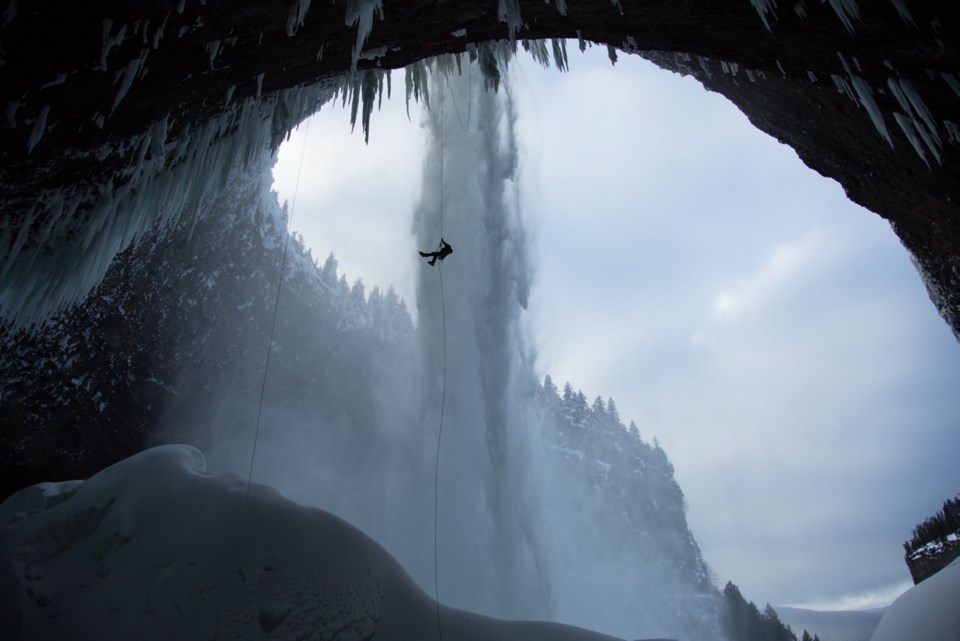ON STAGE
What: Nat Geo Live Presents Capturing the Impossible
Where: Royal Theatre
When: Nov. 20, 7 p.m.
Tickets: $37.50-$44.50 from the Royal McPherson box office, online from rmts.bc.ca or by phone at 250-386-6121
Squamish-based adventure filmmaker Bryan Smith lives in an area of the province known for its natural beauty. The only problem is that Smith is rarely around to film it.
“The irony is that I probably spend more time filming away from here than I do in Squamish,” the Michigan-bred Smith, who married a woman from the area, said with a laugh. “So I cherish the times when we can do stuff in my backyard, when a projects fits. It’s fertile ground for filmmaking, but it’s also an incredibly inspiring place to live. It works on many levels, even though we don’t get to shoot here all the time.”
Smith has parlayed his affinity for the outdoors into Capturing the Impossible, a multimedia presentation by National Geographic set for the Royal Theatre on Nov. 20. The motivation behind the project was to help people better understand the deep connection humans have with nature, and how pushing the outer edges of adventure shapes our society. “The wow factor of adventure often supercedes everything else. But while I hope people get that from this presentation, there’s a lot more to take away from expedition stories than: ‘Whoa, man, that’s crazy.’ ”
Capturing the Impossible is about taking risks, but not in a thrill-seeking way. The latest instalment in the theatre’s National Geographic Live series might seem like yet another “extreme” adventure aimed at adrenaline junkies fuelled by energy drinks and reckless attitudes, but that couldn’t be further from the truth, Smith said. “The motivations of explorers and expeditioners are not rooted in adrenaline. They are rooted in determination and a willingness to go in the unknown. These are the people that help us understand what our potential is as humans.”
He frames the presentation within the parameters of his “60-40 rule,” which he applies to every project he undertakes. “There’s a 40 per cent chance it is not going to work,” he said with a mischievous laugh. “Engaging in projects that have a high probability of failure makes for great stories. These are the expedition stories that everyone wants. Everyone is after that edge of uncertainty.”
Several one-hour documentaries he has worked on form the narrative arc of his presentation, from an ice-climbing expedition at Helmcken Falls in Wells Gray Provincial Park to a paragliding project with two vol-bivouac (fly-campers) who travelled the entire length of the Alaska Range over some of the tallest peaks in North America.
Smith understands that what he is doing isn’t for everyone. But there is a higher purpose to his projects. “I really believe all of us are better people by engaging in the unknown, by trying things that we are not entirely sure will work. By problem solving, we come out the back end knowing a lot more than we ever knew before.”
Some of the most arresting footage in his presentation was from a kayaking expedition in Papua New Guinea that put Smith and his team at the bottom of a gorge nicknamed The Grand Canyon of the Pacific.
“I was a professional whitewater kayaker, and when I looked at this expedition, there was no way in hell I was even remotely thinking about paddling that river. It was on a level I had never experienced before, in terms of commitment.”
Smith started making films during his kayaking days, and was inspired to do so in 2008 with a six-minute film, 49 Megawatts. His first attempt at filmmaking was inspired by the natural beauty of the Ashlu River near Squamish, rugged corners of which few people had ever seen. The area was under threat of a hydroelectric dam project at the time, and Smith wanted to show Squamish-Lillooet regional officials pushing for a river-based energy project what they were in danger of ruining.
“It is arguably the best river on the Sea-to-Sky corridor, in terms of recreation and pure beauty. I remember asking these officials at one point if they had ever seen inside of the Ashlu Canyon, and it was a unanimous no. It was at that moment I decided I was making a film. This was more important than where the pencil meets the paper.”
Though 49 Megawatts was unsuccessful in its bid to stop the dam, it led to a career in filmmaking, which has since taken Smith to rivers in India, Peru, and Russia, among other locales.
“It cemented the idea of what I was going to do: I’m going to be a filmmaker.”



